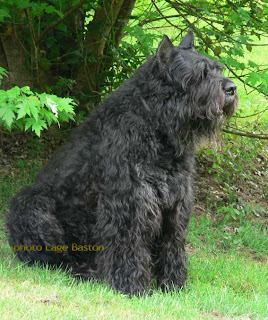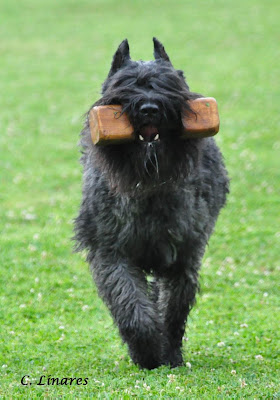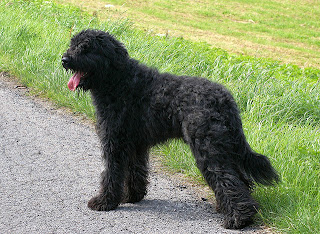Bouvier des Flandres origin Belgium dog in the late 19th century, a program of selective breeding that would eventually produce the dog we know today as the Bouvier was begun in the farming regions of Belgium. Documentation of his ancestry is cloudy, but his beginnings are loosely attributed to a type of sheepdog (berger), the Dutch Griffon, and the Barbet, or waterdog.
By 1910, specific interest in this tousle-coated herder and protector grew as far as the cattle areas near the river Lye valley. At that time, Bouvier des Flandres were being used as drovers, draft animals, activators for churning mills, and farm and family protectors. Common characteristics were bobtails, cropped ears, harsh tousled coats, and perfect instincts for guarding his flock, home, and family. In those days, tails and ears were routinely shortened because they were easy targets for farm predators. The first "Standard" for the Bouvier des Flandres was developed in 1912. Then during World War I (and later during World War II), as the home territory of the Bouvier des Flandres became a battlefield, their numbers were drastically cut almost to extinction! Those who stayed, worked as ambulance litter pullers and military tracking aides. Only a few escaped to other countries.
Those who survived, some taken to France and the Netherlands, became part of discriminating breeding programs for a particular type. The Club National Belge du Bouvier des Flandres, formed in Ghent early in 1922, formulated specific qualities of type for future breeding. The Bouvier came to America in the late 1920's and now extends throughout the United States and Canada.
The legacy of the Bouvier has produced many admirable qualities in this breed. He is a square, powerfullybuilt dog, rugged and formidable in appearance. His harsh double coat protects him in all types of weather; his keen sense of smell and watchful gaze make him a most suitable farm dog. He thrives on plenty of room to work and exercise, but he is not an outdoor dog: he must live with his loving people his "flock." He is agile, alert, intelligent, with character, great spirit and fearlessness; yet, he is serene in disposition and even in temperament. The average size of a Bouvier male is about 26" at the withers, 25" for a female, with an approximate weight span of 70 to 110 pounds. Coloring ranges from black to grey with a variety of colors in between, including fawn and salt-and-pepper.
Today, the Bouvier des Flandres acts as a family friend and protector, farm dog, shepherd, and guide dog for the blind and hearing impaired. His intelligence, sense of threat discrimination and keen scenting ability enables him to excel in police work, tracking and drug detection. Owning a Bouvier, like any dog, requires love, patience, training, a good bit of grooming, a willingness to exercise the dog and to pay for regular veterinary care, a desire to have a companion who will follow you around the house, keeping an eye on you, and a commitment to complete at least one set of good obedience classes.
The Bouvier des Flandres was originally bred as an all-purpose farm dog. This called for a dog that could be used for herding livestock, for pulling carts, as a watchdog/guard dog, and as a family companion. The Bouvier needed to be calm and non-agressive but bold when the need arose. These qualities are found today. Bouvier des Flandres are exceptionally good with children but tend to be aloof with adults other than those of their family. Because of their size and strength, Bouviers need obedience training and a confident owner. They are bright but not blindly obedient and may seem stubborn.
Bouviers are calm indoors, thus suitable even for apartments. They do require a great deal of outdoor exercise. A fenced yard is needed, as they tend to herd moving objects (child on bike, etc.). They are territorial and protective of the areas they consider theirs the "NO TRESPASSING" bark is awesome! However, they will not become aggressive unless absolutely necessary. This trait carries over to other dogs, whom they tend to ignore when in public place
Breed standards call for docking of the tails and optional cropping of the ears, but dogs can show up in shelters and pounds without these alterations. Bouviers range in color from a black brindle to grey to fawn. Their outer coat texture is harsh and tousled, while the undercoat is thick and soft. Shedding is minimal. They must be brushed thoroughly once a week (half an hour or more) and trimmed professionally every six to eight weeks. Under normal circumstances, frequent baths are not required or recommended.
Bouvier des Flandres males generally range from 24" to 28" at the shoulder blades and from 90 to 115 pounds. Females are usually 23" to 27" and weigh 70 to 95 pounds. Larger dogs can occur but are usually not agile and often have a shortened life span. The usual life span is 11 to 13 years, although some live to the age of 15. Bloat may be a problem, so two feedings a day are recommended instead of one large meal. Hip dysplasia, Hypothyroidism, and Lymphosarcoma can also occur in Bouviers. Because of reproductive problems, female Bouvier pets should be spayed.















0 comments:
Post a Comment